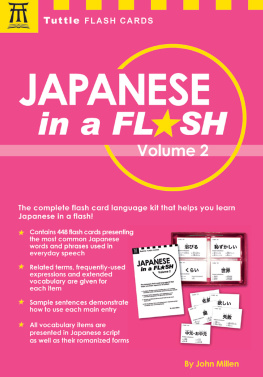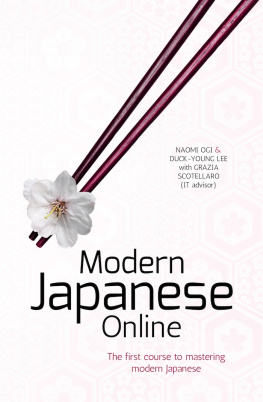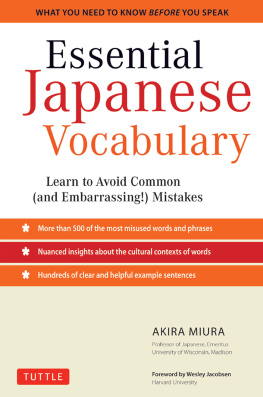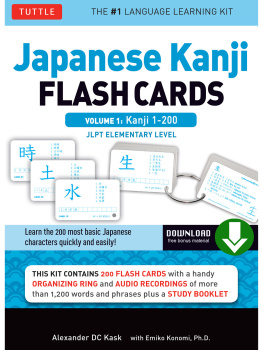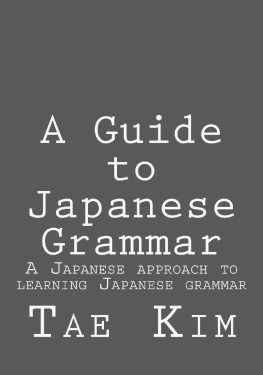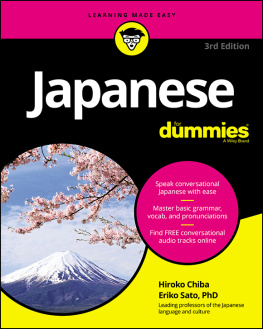Speak Japanese in 90 Days: A Self Study Guide to Becoming Fluent Volume Two Copyright Kevin Marx 2017 Smashwords Edition All rights reserved. No part of this publication maybe reproduced or transmitted in any form or by any means,electronic or mechanical, including photocopying, recording, or anyother information storage and retrieval system, without priorpermission in writing from the author.
Table of Contents
Intermediate Basics
Conjunctions and Clauses
Intermediate Grammar
Intermediate Adjective Grammar
Upper Intermediate Grammar
Time Expressions
Foreword This is the second book in the series SpeakJapanese in 90 Days. The goal of these two books is to not onlyteach you Japanese grammar points, but also to teach you how toself-study effectively. If you have studied with Volume One, youhave likely learned how to effectively memorize new vocabulary andgrammar points. Volume Two will help you move beyond simplememorization, and introduce a new study method to build fluency.Volume Two covers the rest of the grammar tested in the JLPT N4 aswell as all of the grammar in the JLPT N3, and even a few grammarpoints from the JLPT N2.
This book consists of 90 lessons that canbe studied in one day each. There are 74 grammar lessons and 16reading reviews. Thank you for your purchase, I hope you enjoystudying with this book!
How to Study
Grammar
Like Volume One, at the endof each lesson, there will be a template to create a grammar notecard which will help you memorize and review the grammar point. Onone side of the card write the grammar rule in English, as well asone of the example sentences provided, and on the other side, writethe grammar rule in Japanese, along with the Japanese translation.Just like you did in Volume One, practice saying these sentencesout loud at least three times a day, ten times each, for a total ofthirty times, and you may find that you can automatically recallthe sentences without making much effort. In addition to this, Iwant you to try and create a sentence on your own using the newgrammar, this is called practicing, as opposed to studying . As mentioned in Volume One, practicing is just as importantas studying.
If you don't have a native Japanese person to practiceyour own sentence with, try finding online resources where you canpractice. There are many online resources that will help you find alanguage partner. It is extremely important that you try using thegrammar on your own. Making mistakes will help you learn fasterthan any amount of studying. That is to say: practice makesperfect.
Vocabulary
You may notice that thisbook does not have ten vocabulary words per lesson like Volume One.The reason for this is that the JLPT N3 tests over 5000 possiblewords, and after learning the most common 1000 words from VolumeOne, different students have different needs for vocabulary.
Toincrease your vocabulary you need to start reading. There are 16reading sections in this book that are designed to practice thegrammar previously learned, however, these readings are not enoughfor you to significantly increase your Japanese vocabulary. Youneed to find some reading material that fits your Japanese goals.At this stage, I recommend finding some Japanese comic books thatare aimed at younger audiences, because they contain (readings printed above the kanji). If you do not live near aJapanese book retailer, you can find them in online retailers.There are many websites that host free content to read as well.When you read, be sure to say everything out loud. Read a page oncethrough, and then go back look up words you don't know, and make aflash card. At this level, you may want to limit yourself to fivewords a day.
As words become more abstract, they become harder tomemorize, and the goal of 10 words a day outlined in Volume Onebecomes more and more difficult. After you have drilled the words,go back and read the page once again. Continue to review old pagesand old vocabulary words along with new ones. Try making your ownsentences with the new vocabulary words, and say everything outloud.
Studying Vocabulary with Flash Cards
On both sides of the cardwrite the numbers 1-10. On one side write the English word and onthe other side write the Japanese equivalent.
Read word numberone out loud .Flip the card. Read the Japanese equivalent word out loud. Go on to thesecond word. Do this at least ten times for each word. It isextremely important that you say the words out loud. You brain will play trickson you, and you may begin to memorize the order of the words on thecard, so it is important to mix them up.
Do the odd words, then dothe even words. Do the words backwards. You can also switch thelanguage you start with. Start on the English side to improve yourspeaking, start on the Japanese side to improve your reading andlistening. Say everything outloud.
Kanji
Now that you are past thebeginner level of Japanese, you need to start studying kanji moreseriously.
As stated in Volume One, i n myopinion, the best kanji resource available is the Kanji Learner's Course byAndrew Scott Conning (Kodansha USA, 2013), which can be used withan excellent series of graded readingsets and a sequential wall chart . These resources are especially good because they will helpyou build your vocabulary while at the same time learning kanjimeanings and readings. Formatting and Verb Terminology The vocabulary wordspresented in the readings will have the word written in or , followed bythe [ ] inbrackets, followed by the English meaning in bold. Words that areusually written with kana alone will be noted with (UK),meaning usuallykana . The example sentences in this book will havethe following format: The English sentence inbold, followed by the Japanese sentenceusing only and ,followed by the same Japanese sentence as it would normally appearusing [ ]. Japanesesentences often have many different possible translations, and soyou may see some example sentences with two English translations.Translations that show the literal meaning will be represented inparentheses and preceded by Lit.
Verb Form Names
The different conjugations of verbs in thisbook have unique, easy to understand names that you may not befamiliar with, as many resources give them different names.
Pleaseread the following explanations: U-Form : This willrefer to the casual present tense form of verbs, also called theDictionary-Form. Examples: [ ] [ ] I-Form : This refersto the conjugation of verbs causing verbs to end in the sound . This is alsocalled the Polite-Form. It is combined with to make polite present tensesentences. Examples: [ ] [ ] A-Form : Thisrefers to the conjugation of verbs causing verbs to end in the sound. This isalso called the Negative-Forms. It is combined with to make casualnegative present tense sentences.
Examples: [] [ ] E-Form : This refersto the conjugation of verbs causing verbs to end in the sound . This is also calledthe Imperative, Conditional, or Potential-Form. Examples: [ ] [ ] O-Form : This refersto the conjugation of verbs causing verbs to end in and verbs to end in the sound. This isalso called the Volitional or Presumptive-Form. Examples: [ ] [ ] Te-Form : This refersto the conjugation of verbs causing them to end in . Examples: [ ] [ ] Ta-Form : This refersto the conjugation of verbs causing them to end in .
It is used for casualpast tense sentences. Examples: [ ] [ ] NaiDe-Form : This refers toone of the negative Te-Forms, ending in . It is used for negativecommands, and to say without doing or instead ofdoing. Examples: [ ] [ ] Nakute-Form : Thisrefers to one of the negative Te-Forms, ending in . It is used to say
Next page


